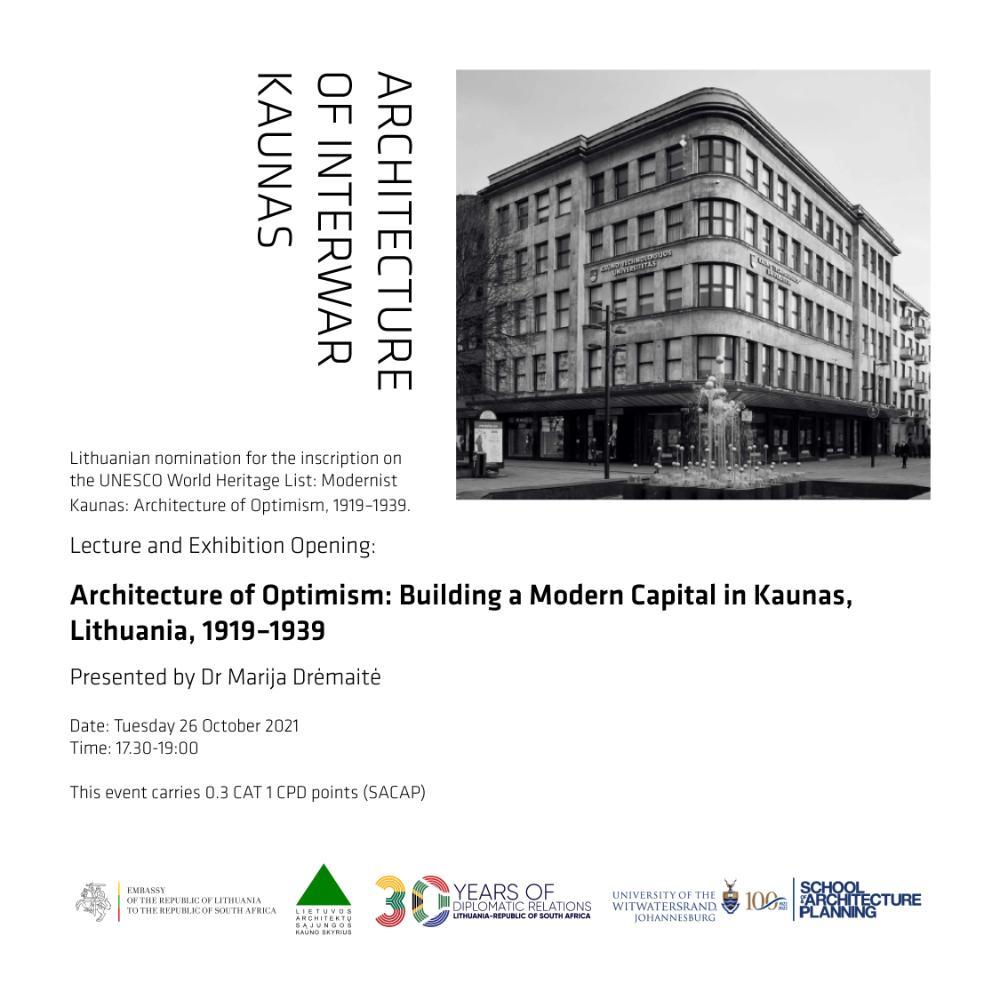
Architecture of Interwar Kaunas: Lecture and Exhibition Opening
Tuesday 26th of October 2021 from 17.30-19.00
This event carries 0.3 CAT 1 CPD points (SACAP). The CPD form will be shared in the chat at the beginning of the event and will remain open until 20.00. For CPD related queries, email SoAP’s CPD Department: CPD.Wits@wits.ac.za. For general queries and technical support, email: media.soap@wits.ac.za.
Join the opening lecture on MS TEAMS
As Lithuania seeks to inscribe Kaunas Modernist architecture on the UNESCO World Heritage List, the Embassy of the Republic of Lithuania, together with the School of Architecture and Planning at the University of the Witwatersrand, present the exhibition "ARCHITECTURE OF INTERWAR KAUNAS".
The exhibition introduces the objects of modern architecture built in Kaunas in the 1920s and the 1930s as a doubtless achievement of the country’s cultural, intellectual and state maturity. During two decades Kaunas was the capital of Lithuania, thus developing from a marginal provincial town into an important architectural centre of the region, which was following the modern architecture of interwar Europe and interpreting it in local context. The exhibition seeks to show how seamlessly, in twenty years, the architects of a young country blended into the European architectural context, represented Lithuania and contributed to the development of a modern European state.
Gintaras Balčytis, organizer, compiler and curator of this exhibition, is a well-known Lithuanian architect, awarded the most important awards for architecture and art in Lithuania. He is the founder and organizer of the Kaunas Architecture Festival KAFe. Since 2008 he is an Assoc. Professor of Kaunas University of Technology, Faculty of Civil Engineering and Architecture.
Photographers: Gintaras Česonis and Rymantas Penkauskas

Following the Curator's Introduction, Dr Marija Drėmaitė will present the opening lecture entitled:
Architecture of Optimism: Building a Modern Capital in Kaunas, Lithuania, 1919–1939
The new national states that emerged on the European map in 1918, after the collapse of the great European empires, became enthusiastic participants in the race to modernise, hoping to keep pace with global trends and become more European in the process. Renewal was the central goal of many European cities, particularly those which were restored or newly designated as administrative capitals, such as Kaunas, the provisional capital of the Republic of Lithuania in 1919-1939. These cities were faced with similar challenges: the need to rid themselves of imperial pasts, and to change their urban environment, create new political centres and construct new government facilities. Kaunas of 1919-1939 presents a unique transformation of a provincial town into a modernist capital city.
Marija Drėmaitė is a Secretary General of the Lithuanian National Commission for UNESCO and a Professor at Vilnius University, Faculty of History. Her research is focused on 20th century architecture and cultural heritage. She is the author of Baltic Modernism: Architecture and Housing in Soviet Lithuania (Berlin: DOM Publishers, 2017) and edited volume of Architecture of Optimism: The Kaunas Phenomenon, 1918–1940 (Vilnius: Lapas, 2018). She was an expert group leader in preparation of the UNESCO World Heritage nomination file “Modernist Kaunas: Architecture of Optimism, 1919–1939”.
